Plasma cutting is a popular method of cutting metal and other materials. It is a high–speed, precise method used in many industries, and it can be dangerous if safety guidelines are not followed.
This article will discuss the safety precautions that should be taken when working with a plasma cutter. We will look at the personal protective equipment (PPE) that should be worn, the risks involved, and the steps that should be taken to ensure a safe working environment.
Key Risk Exposure
Let me first discuss the main risk exposures that you may face while working with a plasma cutter. It will help you understand the importance of safety practices.

1. Electrical Shock: Plasma cutters use a high-voltage electrical current to generate the plasma arc, so it is important to take proper safety precautions when operating a plasma cutter, such as wearing the appropriate safety gear and using a ground clamp.
2. Fire and Explosion: Plasma cutting creates a lot of heat, so there is a risk of fire or explosion when working with flammable materials. It is important to use appropriate ventilation and keep a fire extinguisher nearby when using a plasma cutter.
3. Eye Injury: It is crucial to wear the appropriate eye protection when using a plasma cutter. The intense light created by the plasma arc can cause eye injury if proper safety precautions are not taken.
4. Skin Burns: The arc created by the plasma cutter can cause serious burns to exposed skin. It is important to wear the appropriate clothing and gloves when operating a plasma cutter.
Metal cutting can affect the skin in a variety of ways. Depending on the type of metal cutting, the risk of skin irritation, burns, or lacerations can increase. The heat from the cutting process can cause burns or irritation, while sharp edges of the metal can cause lacerations. Additionally, metal shavings can become embedded in the skin, which can cause irritation and infection.
It is important to use protective gear, such as gloves and safety glasses when cutting metal to minimize the risk of skin irritation and injury.
5. Hearing Loss: The loud noise created by the plasma cutter can cause hearing loss if proper hearing protection is not worn. In terms of the effect on the ears, metal cutting can be loud and can cause hearing damage. Hearing protection, such as earplugs or earmuffs, should be worn to minimize the risk of hearing damage.
6. Breathing Problem: Metal welding toxic fumes can have a variety of negative health effects. The most common health effects are related to the inhalation of the fumes. These fumes contain a variety of toxic chemicals, including fine particles, gases, and vapors. These toxic chemicals can cause irritation to the eyes, nose, throat, and lungs.
Inhaling the fumes may also cause headaches, dizziness, fatigue, and even vomiting. Long–term exposure to welding fumes can lead to an increased risk of developing certain types of cancer, such as lung cancer.
In addition, these fumes can also damage the nervous system and respiratory systems, leading to long–term health problems. Therefore, it is important for welders to take appropriate safety measures to limit their exposure to welding fumes.
Risks associated with air compressor
If you are using an air compressor with your plasma cutter, these are the risk areas you need to keep your eyes on:
1. Explosion Hazards: Air compressors can potentially explode due to a build–up of pressure from too much air being compressed in a small area, leading to a blast of air or shrapnel. To avoid this, compressors must be kept at the appropriate pressure level and should be inspected regularly.
2. Fire Hazards: Compressors generate heat and can ignite combustible materials if used in an area with flammable materials. This can be avoided by keeping the area around the compressor clean and free from combustible materials.
3. Electrical Hazards: The electrical components of an air compressor can be dangerous if not properly maintained or used in an area with excess moisture or water. To avoid electrical shock, use GFCI outlets and make sure all electrical components are in good working order.
4. Noise Hazards: Some air compressors are extremely loud and can cause hearing damage if used in enclosed spaces with no hearing protection. To avoid this, make sure the compressor is used in a well–ventilated area and that hearing protection is worn.
Safety Practices for plasma cutting
These are the safety precautions you should always follow while working with the plasma cutters & any other metal cutting & welding activities.

- Wear appropriate personal protective equipment (PPE), including a face shields, heavy leather gloves, and protective clothing.
- Ensure the cutting area is free of flammable materials and that all nozzles and hoses are undamaged and secure.
- Check all equipment for proper grounding and electrical safety.
- Make sure the plasma cutter is set to the correct pressure and current settings for the material being cut.
- Keep the torch at an angle to the workpiece and maintain a steady speed while cutting.
- Avoid stopping the torch while cutting to prevent the molten metal from congealing and blocking the nozzle.
- Use an external gas shield to protect the operator from airborne contaminants.
- Properly store and maintain the plasma cutter according to the manufacturer‘s instructions.
- Regularly inspect the nozzle for damage or wear.
- Disconnect the power whenever the plasma cutter is not in use.
Follow these best practices to mitigate the risks arising from air compressor usage:
- Always read and understand the manufacturer’s instructions before operating an air compressor.
- Wear safety glasses, hearing protection, and other protective equipment when operating an air compressor.
- Disconnect the air compressor when not in use.
- Don’t run the air compressor in an enclosed space.
- Regularly inspect the air compressor for worn or damaged parts and ensure that all components are securely fastened.
- Avoid overfilling the tank and ensure the pressure gauge is properly calibrated.
- Use only recommended lubricants to keep the air compressor running smoothly.
- Repair or replace worn or damaged parts as soon as possible.
- When disconnecting air hoses, make sure all air pressure has been expelled.
- Store air compressor tools and accessories in a safe, dry location.
To mitigate the risks associated with air compressors, make sure to calibrate air as per the altitude, humidity, and other environmental factors. Follow this for more.

Some cable organizing tips
Organizing cables in your working area is equally important to other listed safety practices.
- Label Cables: Labeling your cables helps you organize them better and makes them easier to find when needed.
- Use Cable Ties: Cable ties are a great way to keep cables in order and untangled.
- Wall Clips: Wall clips are a great way to organize cables near the wall.
- Cable Trays: Cable trays are helpful for organizing large bundles of cables in the garage.
- Cable Hangers: Cable hangers are great for suspending cables from the ceiling in your garage.
- Cable Conduits: Cable conduits are the best way to protect and organize your cables in the garage.
- Cable Raceways: Cable raceways are a great way to organize and hide your cables in the garage.
Why the arcs is important to keep in angle?
The angle of the plasma cutter arc needs to be kept in order to maintain an optimal distance between the plasma cutting tip and the workpiece. This distance is referred to as the standoff distance and is important for achieving an efficient and clean cut.
If the arc is not held at the correct angle, the distance will either be too close or too far, resulting in either an inefficient cut or a poor-quality cut.
Additionally, the angle of the arc helps to direct the flow of the plasma and the heat generated from the cutting process, allowing for the most accurate and precise cut.
Most importantly, keeping the arc at a perfect angle would save you from any risks associated with metal cutting.
Recent Accidents happened with Plasma Cutter
1. In October 2020, two workers in the US were injured in an accident involving a plasma cutter. The incident occurred at an automotive shop and the workers were attempting to cut away damaged parts of a vehicle. (Source)
2. In November 2020, a worker in Canada was injured after a plasma cutter exploded and caught fire. The worker suffered burns to his hands and face. (Source)
3. In December 2020, a factory worker in the UK was injured after a plasma cutter exploded and set fire to nearby materials. The worker suffered burns to his hands and face. (Source)
4. In January 2021, a welder in Mexico was injured after a plasma cutter malfunctioned and created a spark that ignited a fire. The worker suffered burns to his face and hands. (Source)
Recent Accidents with air compressor
1. In December 2020, a worker in Iowa was critically injured in an accident involving an air compressor. According to the Occupational Safety and Health Administration, the worker was using a portable air compressor to power a pneumatic tool and the compressor suddenly exploded, causing the worker to be hit by debris. Source: Occupational Safety and Health Administration
2. In June 2020, a worker in California was killed in an accident involving an air compressor. According to the California Division of Occupational Safety and Health, the worker was using an air compressor to power a pneumatic tool when the compressor suddenly exploded, causing the worker to be hit by debris. Source: California Division of Occupational Safety and Health
3. In April 2020, a worker in Pennsylvania was killed in an accident involving an air compressor. According to the Pennsylvania Department of Labor and Industry, the worker was using an air compressor to power a pneumatic tool when the compressor suddenly exploded, causing the worker to be hit by debris. Source: Pennsylvania Department of Labor and Industry
Let’s conclude
In conclusion, plasma cutting safety practices are essential for any welding job. Plasma cutting can be a potentially hazardous process, and it is necessary to understand the risks associated with it. By following the safety practices and guidelines outlined in this article, you will be better prepared to safely carry out your plasma cutting activities. Always remember to wear the proper safety gear, and be sure to follow the manufacturer’s instructions to ensure the best and safest results.





